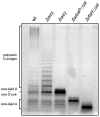The outer core lipopolysaccharide of Salmonella enterica serovar Typhi is required for bacterial entry into epithelial cells
- PMID: 16495526
- PMCID: PMC1418631
- DOI: 10.1128/IAI.74.3.1555-1564.2006
The outer core lipopolysaccharide of Salmonella enterica serovar Typhi is required for bacterial entry into epithelial cells
Abstract
Salmonella enterica serovar Typhi causes typhoid fever in humans. Central to the pathogenicity of serovar Typhi is its capacity to invade intestinal epithelial cells. The role of lipopolysaccharide (LPS) in the invasion process of serovar Typhi is unclear. In this work, we constructed a series of mutants with defined deletions in genes for the synthesis and polymerization of the O antigen (wbaP, wzy, and wzz) and the assembly of the outer core (waaK, waaJ, waaI, waaB, and waaG). The abilities of each mutant to associate with and enter HEp-2 cells and the importance of the O antigen in serum resistance of serovar Typhi were investigated. We demonstrate here that the presence and proper chain length distribution of the O-antigen polysaccharide are essential for serum resistance but not for invasion of epithelial cells. In contrast, the outer core oligosaccharide structure is required for serovar Typhi internalization in HEp-2 cells. We also show that the outer core terminal glucose residue (Glc II) is necessary for efficient entry of serovar Typhi into epithelial cells. The Glc I residue, when it becomes terminal due to a polar insertion in the waaB gene affecting the assembly of the remaining outer core residues, can partially substitute for Glc II to mediate bacterial entry into epithelial cells. Therefore, we conclude that a terminal glucose in the LPS core is a critical residue for bacterial recognition and internalization by epithelial cells.
Figures







Similar articles
-
Different sugar residues of the lipopolysaccharide outer core are required for early interactions of Salmonella enterica serovars Typhi and Typhimurium with epithelial cells.Microb Pathog. 2011 Feb;50(2):70-80. doi: 10.1016/j.micpath.2010.11.001. Epub 2010 Nov 12. Microb Pathog. 2011. PMID: 21075194
-
Epithelial cell contact-induced alterations in Salmonella enterica serovar Typhi lipopolysaccharide are critical for bacterial internalization.Cell Microbiol. 2001 Nov;3(11):763-72. doi: 10.1046/j.1462-5822.2001.00154.x. Cell Microbiol. 2001. PMID: 11696036
-
Type IV(B) pili are required for invasion but not for adhesion of Salmonella enterica serovar Typhi into BHK epithelial cells in a cystic fibrosis transmembrane conductance regulator-independent manner.Microb Pathog. 2011 Nov;51(5):373-7. doi: 10.1016/j.micpath.2011.07.005. Epub 2011 Jul 18. Microb Pathog. 2011. PMID: 21782926
-
Role of antigens and virulence factors of Salmonella enterica serovar Typhi in its pathogenesis.Microbiol Res. 2012 Apr 20;167(4):199-210. doi: 10.1016/j.micres.2011.08.001. Epub 2011 Sep 25. Microbiol Res. 2012. PMID: 21945101 Review.
-
Host restriction in Salmonella: insights from Rab GTPases.Cell Microbiol. 2014 Sep;16(9):1321-8. doi: 10.1111/cmi.12327. Epub 2014 Aug 5. Cell Microbiol. 2014. PMID: 24957519 Review.
Cited by
-
Dam methylation participates in the regulation of PmrA/PmrB and RcsC/RcsD/RcsB two component regulatory systems in Salmonella enterica serovar Enteritidis.PLoS One. 2013;8(2):e56474. doi: 10.1371/journal.pone.0056474. Epub 2013 Feb 13. PLoS One. 2013. PMID: 23418573 Free PMC article.
-
Steering Phages to Combat Bacterial Pathogens.Trends Microbiol. 2020 Feb;28(2):85-94. doi: 10.1016/j.tim.2019.10.007. Epub 2019 Nov 16. Trends Microbiol. 2020. PMID: 31744662 Free PMC article. Review.
-
Statistical analysis of the Bacterial Carbohydrate Structure Data Base (BCSDB): characteristics and diversity of bacterial carbohydrates in comparison with mammalian glycans.BMC Struct Biol. 2008 Aug 11;8:35. doi: 10.1186/1472-6807-8-35. BMC Struct Biol. 2008. PMID: 18694500 Free PMC article.
-
Salmonella enterica serovar enteritidis antimicrobial peptide resistance genes aid in defense against chicken innate immunity, fecal shedding, and egg deposition.Infect Immun. 2014 Dec;82(12):5185-202. doi: 10.1128/IAI.02387-14. Epub 2014 Sep 29. Infect Immun. 2014. PMID: 25267840 Free PMC article.
-
Trade-Offs of Escherichia coli Adaptation to an Intracellular Lifestyle in Macrophages.PLoS One. 2016 Jan 11;11(1):e0146123. doi: 10.1371/journal.pone.0146123. eCollection 2016. PLoS One. 2016. PMID: 26752723 Free PMC article.
References
-
- Alonso, A., and F. García-del Portillo. 2004. Hijacking of eukaryotic functions by intracellular bacterial pathogens. Int. Microbiol. 7:181-191. - PubMed
-
- Bengoechea, J. A., H. Najdenski, and M. Skurnik. 2004. Lipopolysaccharide O antigen status of Yersinia enterocolitica O:8 is essential for virulence and absence of O antigen affects the expression of the other Yersinia virulence factors. Mol. Microbiol. 52:451-469. - PubMed
-
- Bittner, M., S. Saldías, C. Estévez, M. Zaldívar, C. L. Marolda, M. A. Valvano, and I. Contreras. 2002. O-antigen expression in Salmonella enterica serovar Typhi is regulated by nitrogen availability through RpoN-mediated transcriptional control of the rfaH gene. Microbiology 148:3789-3799. - PubMed
-
- Bittner, M., S. Saldías, F. Altamirano, M. A. Valvano, and I. Contreras. 2004. RpoS and RpoN are involved in the growth-dependent regulation of rfaH transcription and O antigen expression in Salmonella enterica serovar Typhi. Microb. Pathog. 36:19-24. - PubMed
-
- Cherepanov, P. P., and W. Wackernagel. 1995. Gene disruption in Escherichia coli: TcR and KmR cassettes with the option of Flp-catalized excision of the antibiotic-resistance determinant. Gene 158:9-14. - PubMed
Publication types
MeSH terms
Substances
LinkOut - more resources
Full Text Sources
Other Literature Sources

